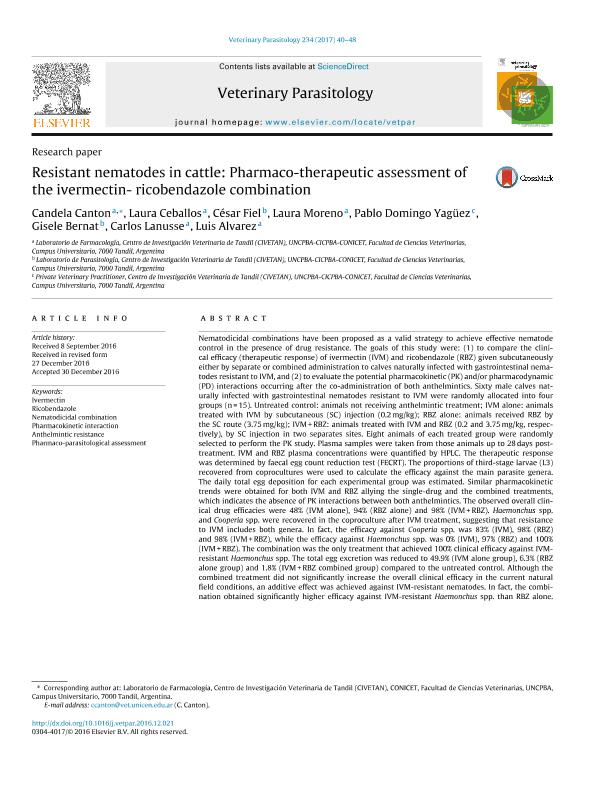Artículo
Resistant nematodes in cattle: Pharmaco-therapeutic assessment of the ivermectin- ricobendazole combination
Cantón, Candela ; Ceballos, Laura
; Ceballos, Laura ; Fiel, Cesar Alberto; Moreno, Laura; Domingo Yagüez, Pablo; Bernat, Gisele; Lanusse, Carlos Edmundo
; Fiel, Cesar Alberto; Moreno, Laura; Domingo Yagüez, Pablo; Bernat, Gisele; Lanusse, Carlos Edmundo ; Alvarez, Luis Ignacio
; Alvarez, Luis Ignacio
 ; Ceballos, Laura
; Ceballos, Laura ; Fiel, Cesar Alberto; Moreno, Laura; Domingo Yagüez, Pablo; Bernat, Gisele; Lanusse, Carlos Edmundo
; Fiel, Cesar Alberto; Moreno, Laura; Domingo Yagüez, Pablo; Bernat, Gisele; Lanusse, Carlos Edmundo ; Alvarez, Luis Ignacio
; Alvarez, Luis Ignacio
Fecha de publicación:
01/2017
Editorial:
Elsevier Science
Revista:
Veterinary Parasitology
ISSN:
0304-4017
Idioma:
Inglés
Tipo de recurso:
Artículo publicado
Clasificación temática:
Resumen
Nematodicidal combinations have been proposed as a valid strategy to achieve effective nematode control in the presence of drug resistance. The goals of this study were: (1) to compare the clinical efficacy (therapeutic response) of ivermectin (IVM) and ricobendazole (RBZ) given subcutaneously either by separate or combined administration to calves naturally infected with gastrointestinal nematodes resistant to IVM, and (2) to evaluate the potential pharmacokinetic (PK) and/or pharmacodynamic (PD) interactions occurring after the co-administration of both anthelmintics. Sixty male calves naturally infected with gastrointestinal nematodes resistant to IVM were randomly allocated into four groups (n = 15). Untreated control: animals not receiving anthelmintic treatment; IVM alone: animals treated with IVM by subcutaneous (SC) injection (0.2 mg/kg); RBZ alone: animals received RBZ by the SC route (3.75 mg/kg); IVM + RBZ: animals treated with IVM and RBZ (0.2 and 3.75 mg/kg, respectively), by SC injection in two separates sites. Eight animals of each treated group were randomly selected to perform the PK study. Plasma samples were taken from those animals up to 28 days post-treatment. IVM and RBZ plasma concentrations were quantified by HPLC. The therapeutic response was determined by faecal egg count reduction test (FECRT). The proportions of third-stage larvae (L3) recovered from coprocultures were used to calculate the efficacy against the main parasite genera. The daily total egg deposition for each experimental group was estimated. Similar pharmacokinetic trends were obtained for both IVM and RBZ allying the single-drug and the combined treatments, which indicates the absence of PK interactions between both anthelmintics. The observed overall clinical drug efficacies were 48% (IVM alone), 94% (RBZ alone) and 98% (IVM + RBZ). Haemonchus spp. and Cooperia spp. were recovered in the coproculture after IVM treatment, suggesting that resistance to IVM includes both genera. In fact, the efficacy against Cooperia spp. was 83% (IVM), 98% (RBZ) and 98% (IVM + RBZ), while the efficacy against Haemonchus spp. was 0% (IVM), 97% (RBZ) and 100% (IVM + RBZ). The combination was the only treatment that achieved 100% clinical efficacy against IVM-resistant Haemonchus spp. The total egg excretion was reduced to 49.9% (IVM alone group), 6.3% (RBZ alone group) and 1.8% (IVM + RBZ combined group) compared to the untreated control. Although the combined treatment did not significantly increase the overall clinical efficacy in the current natural field conditions, an additive effect was achieved against IVM-resistant nematodes. In fact, the combination obtained significantly higher efficacy against IVM-resistant Haemonchus spp. than RBZ alone. Additionally, the epidemiological relevance of the reduction in the number of eggs excreted following the combined treatment is not negligible and should be taken into account in future studies. Further work is required to understand the advantages of nematodicidal combinations in different natural anthelmintic resistance scenarios.
Archivos asociados
Licencia
Identificadores
Colecciones
Articulos(CCT - TANDIL)
Articulos de CTRO CIENTIFICO TECNOLOGICO CONICET - TANDIL
Articulos de CTRO CIENTIFICO TECNOLOGICO CONICET - TANDIL
Articulos(CIVETAN)
Articulos de CENTRO DE INVESTIGACION VETERINARIA DE TANDIL
Articulos de CENTRO DE INVESTIGACION VETERINARIA DE TANDIL
Citación
Cantón, Candela; Ceballos, Laura; Fiel, Cesar Alberto; Moreno, Laura; Domingo Yagüez, Pablo; et al.; Resistant nematodes in cattle: Pharmaco-therapeutic assessment of the ivermectin- ricobendazole combination; Elsevier Science; Veterinary Parasitology; 234; 1-2017; 40-48
Compartir
Altmétricas



